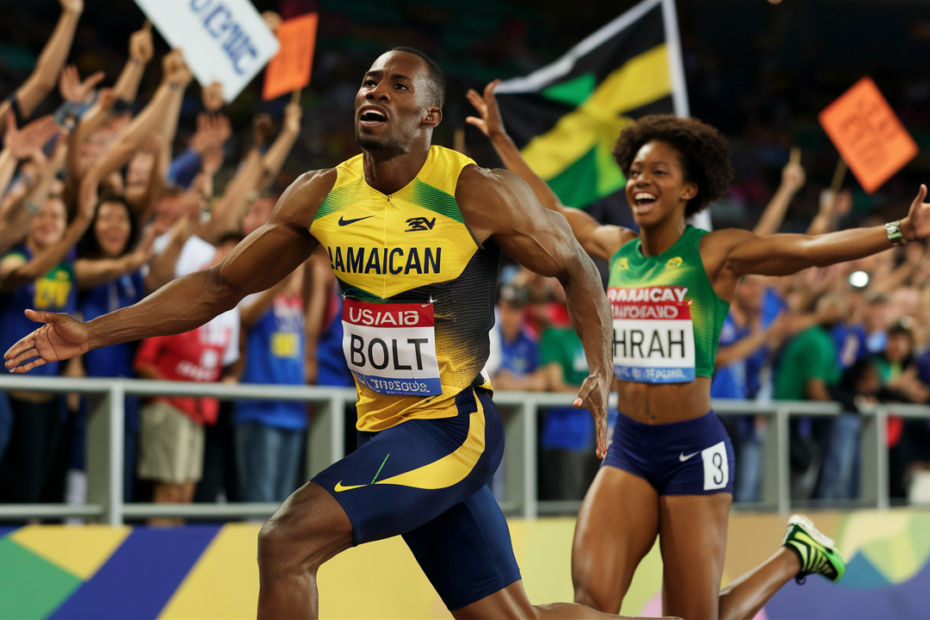As you watch the world’s fastest sprinters explode from the starting blocks, have you ever wondered how today’s Olympic champions compare to those of the past? The 100-meter dash has been the premier showcase of raw human speed since the first modern Olympics in 1896. From those earliest races to the upcoming 2024 Paris Games, the event has captivated audiences and produced legendary athletes. This article will take you on a journey through time, exploring the fastest men and women to ever grace the Olympic track. You’ll discover how records have fallen, techniques have evolved, and new stars have emerged to claim the title of the world’s fastest human.
A Brief History of the 100m at the Olympics
The 100-meter sprint has been a cornerstone of the Olympic Games since their modern revival in 1896. This explosive event has captivated audiences for over a century, showcasing the raw speed and power of the world’s fastest athletes.
Early Years and Evolution
In the inaugural 1896 Olympics, American Thomas Burke clinched gold with a time of 12.0 seconds. The event was initially contested on a grass track, far from today’s high-tech surfaces. The women’s 100m wasn’t introduced until the 1928 Amsterdam Games, where Betty Robinson of the USA triumphed in 12.2 seconds.
Technological Advancements
As the decades progressed, improvements in track surfaces, starting blocks, and timing systems revolutionized the sport. The introduction of fully automatic timing in 1932 and synthetic tracks in the 1960s allowed for more accurate measurements and faster times.
Breaking Barriers
The 10-second barrier in men’s competition was first officially broken by Jim Hines at the 1968 Mexico City Olympics, clocking 9.95 seconds. For women, Florence Griffith-Joyner’s 1988 record of 10.49 seconds still stands today, a testament to her phenomenal speed.
Modern Era
Today, the 100m remains the most anticipated event of the Olympics. Usain Bolt’s dominance from 2008 to 2016 redefined what was possible in sprinting, while athletes like Elaine Thompson-Herah continue to push the boundaries of human speed.
The Fastest Male 100m Sprinters in Olympic History
The Evolution of Olympic Speed
From the inaugural modern Olympics in 1896 to today, the men’s 100m sprint has been a showcase of human speed and athleticism. Over the decades, we’ve witnessed a dramatic progression in race times as training methods, technology, and athlete potential have pushed the boundaries of what’s possible on the track.
Record-Breaking Performances
Usain Bolt of Jamaica stands tall as the fastest man in Olympic history. His breathtaking 9.63-second run at the 2012 London Games remains the Olympic record. Before Bolt’s era, notable sprinters like Carl Lewis and Jesse Owens captivated audiences with their blazing speed. Each Olympics brings the potential for new records, as athletes strive to shave precious hundredths of a second off their times.
Factors Behind Faster Times
Several elements contribute to the increasing speed of Olympic sprinters. Advancements in sports science, nutrition, and biomechanics have allowed athletes to optimize their performance. Additionally, improvements in track surfaces, starting blocks, and timing technology have created ideal conditions for record-setting runs. The competitive nature of the event itself drives athletes to constantly push their limits, resulting in faster times with each Olympic cycle.
List of Fastest Men in Each Olympic
| Year | Olympic Venue | Sprinter Name | Country | Winning Time (seconds) |
|---|---|---|---|---|
| 1896 | Athens | Thomas Burke | USA | 12.0 |
| 1900 | Paris | Frank Jarvis | USA | 11.0 |
| 1904 | St. Louis | Archie Hahn | USA | 11.0 |
| 1908 | London | Reggie Walker | South Africa | 10.8 |
| 1912 | Stockholm | Ralph Craig | USA | 10.8 |
| 1920 | Antwerp | Charley Paddock | USA | 10.8 |
| 1924 | Paris | Harold Abrahams | Great Britain | 10.6 |
| 1928 | Amsterdam | Percy Williams | Canada | 10.8 |
| 1932 | Los Angeles | Eddie Tolan | USA | 10.38 |
| 1936 | Berlin | Jesse Owens | USA | 10.3 |
| 1948 | London | Harrison Dillard | USA | 10.3 |
| 1952 | Helsinki | Lindy Remigino | USA | 10.4 |
| 1956 | Melbourne | Bobby Morrow | USA | 10.5 |
| 1960 | Rome | Armin Hary | Germany | 10.2 |
| 1964 | Tokyo | Bob Hayes | USA | 10.0 |
| 1968 | Mexico City | Jim Hines | USA | 9.95 |
| 1972 | Munich | Valeriy Borzov | USSR | 10.14 |
| 1976 | Montreal | Hasely Crawford | Trinidad & Tobago | 10.06 |
| 1980 | Moscow | Allan Wells | Great Britain | 10.25 |
| 1984 | Los Angeles | Carl Lewis | USA | 9.99 |
| 1988 | Seoul | Carl Lewis | USA | 9.92 |
| 1992 | Barcelona | Linford Christie | Great Britain | 9.96 |
| 1996 | Atlanta | Donovan Bailey | Canada | 9.84 |
| 2000 | Sydney | Maurice Greene | USA | 9.87 |
| 2004 | Athens | Justin Gatlin | USA | 9.85 |
| 2008 | Beijing | Usain Bolt | Jamaica | 9.69 |
| 2012 | London | Usain Bolt | Jamaica | 9.63 |
| 2016 | Rio de Janeiro | Usain Bolt | Jamaica | 9.81 |
| 2021 | Tokyo | Marcell Jacobs | Italy | 9.80 |
| 2024 | Paris | Noah Lyles | USA | 9.79 |
The Fastest Female 100m Sprinters in Olympic History
Breaking Barriers on the Track
Throughout Olympic history, female sprinters have consistently pushed the boundaries of human speed. From the first women’s 100m event in 1928 to the present day, these athletes have shattered records and inspired generations. The progression of the women’s 100m dash showcases not only advancements in training and technique but also the breaking down of societal barriers.
Legendary Names and Lightning-Fast Times
Several names stand out in the annals of Olympic sprinting. Florence Griffith-Joyner, known as “Flo-Jo,” still holds the Olympic record of 10.62 seconds, set in 1988. Her electrifying performances revolutionized the sport. More recently, Jamaica’s Elaine Thompson-Herah blazed to victory in Tokyo 2020, clocking an impressive 10.61 seconds – the second-fastest time ever recorded in Olympic competition.
The Evolution of Women’s Sprinting
The improvement in women’s 100m times over the decades is remarkable. From Betty Robinson’s gold medal-winning 12.2 seconds in 1928 to the sub-11 second performances we see today, female sprinters have consistently redefined the limits of speed. This evolution reflects not just athletic prowess but also advances in training methods, nutrition, and the growing opportunities for women in sports.
List of Fastest Women in Each Olympic
| Year | Olympic Venue | Sprinter Name | Country | Winning Time (seconds) |
|---|---|---|---|---|
| 1928 | Amsterdam | Betty Robinson | USA | 12.2 |
| 1932 | Los Angeles | Stanisława Walasiewicz | Poland | 11.9 |
| 1936 | Berlin | Helen Stephens | USA | 11.5 |
| 1948 | London | Fanny Blankers-Koen | Netherlands | 11.9 |
| 1952 | Helsinki | Marjorie Jackson | Australia | 11.5 |
| 1956 | Melbourne | Betty Cuthbert | Australia | 11.5 |
| 1960 | Rome | Wilma Rudolph | USA | 11.0 |
| 1964 | Tokyo | Wyomia Tyus | USA | 11.4 |
| 1968 | Mexico City | Wyomia Tyus | USA | 11.0 |
| 1972 | Munich | Renate Stecher | East Germany | 11.07 |
| 1976 | Montreal | Annegret Richter | West Germany | 11.08 |
| 1980 | Moscow | Lyudmila Kondratyeva | USSR | 11.06 |
| 1984 | Los Angeles | Evelyn Ashford | USA | 10.97 |
| 1988 | Seoul | Florence Griffith-Joyner | USA | 10.54 |
| 1992 | Barcelona | Gail Devers | USA | 10.82 |
| 1996 | Atlanta | Gail Devers | USA | 10.94 |
| 2000 | Sydney | Marion Jones | USA | 10.75 |
| 2004 | Athens | Yulia Nestsiarenka | Belarus | 10.93 |
| 2008 | Beijing | Shelly-Ann Fraser | Jamaica | 10.78 |
| 2012 | London | Shelly-Ann Fraser-Pryce | Jamaica | 10.75 |
| 2016 | Rio de Janeiro | Elaine Thompson-Herah | Jamaica | 10.71 |
| 2021 | Tokyo | Elaine Thompson-Herah | Jamaica | 10.61 |
| 2024 | Paris | Julien Alfred | Saint Lucia | 10.72 |
Comparing the Fastest Men’s and Women’s Times
When examining the evolution of Olympic 100m sprint times, it’s fascinating to see how both men’s and women’s records have progressed over the years. While men have consistently posted faster times, both genders have made remarkable strides in pushing the boundaries of human speed.
Men’s vs. Women’s Progress
Men’s times have improved from around 12 seconds in the early 1900s to the current world record of 9.58 seconds, set by Usain Bolt in 2009. Women’s times have seen a similar trajectory, dropping from about 13.5 seconds to the current record of 10.49 seconds, held by Florence Griffith-Joyner since 1988.
The gap between men’s and women’s times has remained relatively consistent, with men running about 10% faster on average. This difference is largely attributed to physiological factors such as muscle mass, body composition, and hormone levels.
Notable Milestones
Both genders have achieved significant milestones in the 100m sprint. For men, breaking the 10-second barrier was a watershed moment, first accomplished by Jim Hines in 1968. For women, dipping under 11 seconds was equally momentous, with Wyomia Tyus achieving this feat in 1968 as well.
As we look towards future Olympics, the question remains: how much faster can humans run? While incremental improvements are still possible, we may be approaching the limits of human speed potential in this explosive event.
Will We See Even Faster 100m Times in the Future?
As we look ahead to future Olympic Games, the question on many minds is whether we’ll witness even more breathtaking 100m sprint times. The pursuit of speed continues to push the boundaries of human potential, leaving us to wonder: just how fast can we go?
Technological Advancements
Innovations in track surfaces, starting blocks, and athletic gear continue to evolve. These advancements, coupled with improvements in training techniques and nutrition, may contribute to marginal gains that could shave precious hundredths of a second off current records.
Genetic Factors and Training
Scientists are uncovering more about the genetic factors that contribute to explosive speed. As our understanding grows, training regimens may become even more tailored to individual athletes’ genetic profiles, potentially unlocking new levels of performance.
The Human Limit
Some experts argue that we’re approaching the physiological limit of human speed. However, history has shown that perceived barriers often fall in the face of human determination and scientific progress. The 9.5-second barrier for men and the 10.5-second mark for women remain tantalizing goals for future sprinters to chase.
As we anticipate the next Olympic Games, the world watches with bated breath. Will we see a new generation of sprinters redefine what’s possible on the track? Only time will tell, but the quest for speed remains as exciting as ever.
Conclusion
As you’ve seen, the evolution of 100m sprint times has been remarkable since the early Olympic Games. From humble beginnings to today’s elite athletes, both men and women have continually pushed the boundaries of human speed. The progression demonstrates not only advances in training, nutrition, and technology but also the expanding inclusivity of the Olympics. As we look ahead to Paris 2024, anticipation builds to see if new records will fall. While predicting the next great sprinter is impossible, one thing is certain – the quest for speed will continue to captivate audiences worldwide, inspiring future generations to chase their dreams on the track.



